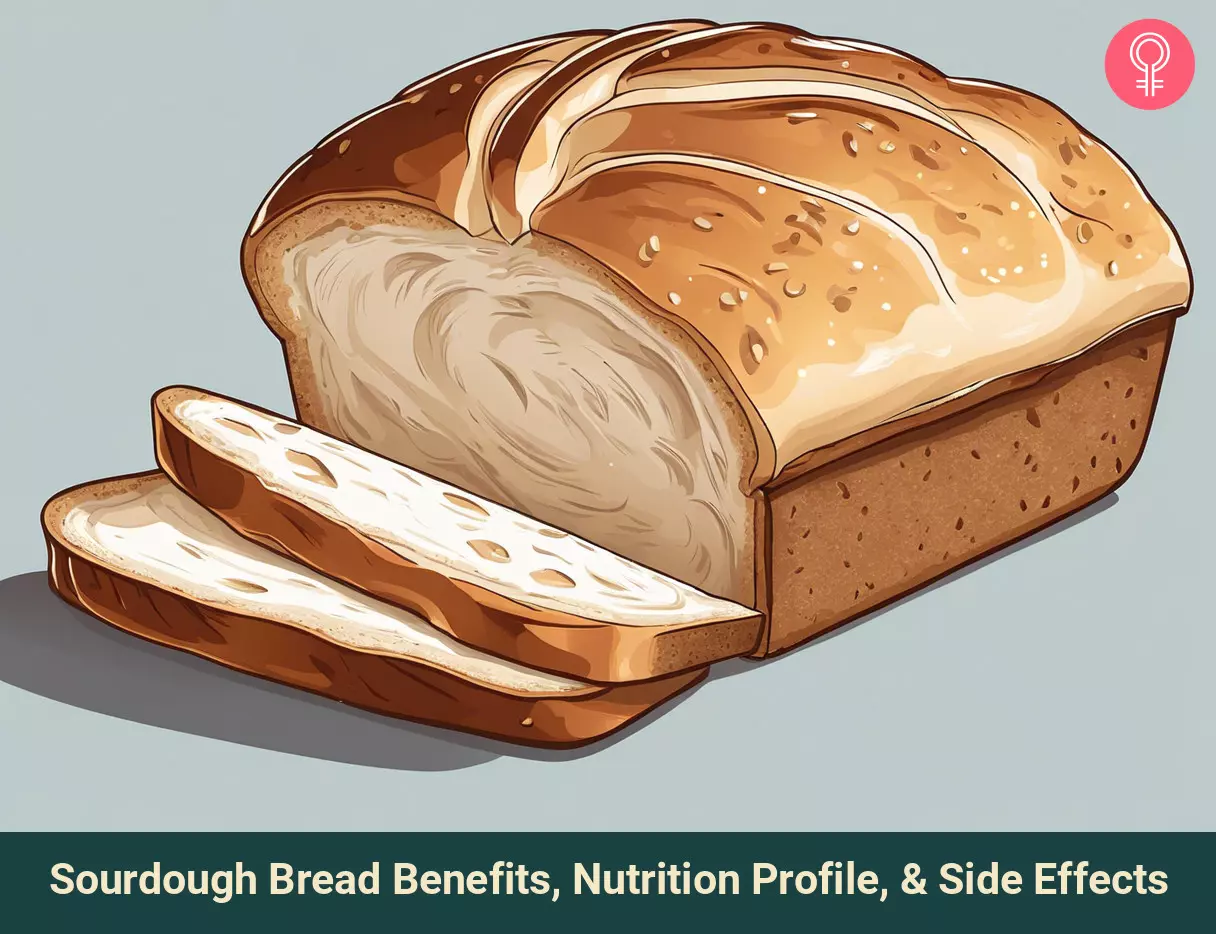This article delves deeper into the potential health benefits of sourdough bread supported by scientific research, its nutritional breakdown, possible side effects, and some easy and delicious homemade recipes. Keep reading.
What Is Sourdough Bread?
Anthony Puopolo What Are Its Benefits? Rich in dietary fiber, helps reduce the risk of coronary heart disease, and aids in weight loss. Who Can Consume It? It is a great addition to the everyday diet. How Often? Around 3 to 4 slices in a day for optimal health. Caution People with gluten intolerance and celiac disease might face severe health issues from its consumption and should consult a healthcare provider before doing so.
, MD, Chief Medical Officer at RexMD, says, “Sourdough bread is a naturally leavened bread made using a fermented ’starter.’ If you are familiar with the process of making something like kombucha, or sauerkraut, a similar process is used in the making of sourdough bread.” It is quite different from our regular bread. He explains, “Without an activated yeast, the bread rises from natural bacteria in the starter. In many cases, this causes sourdough to be easier on those with gluten sensitivities. It also contains healthy bacteria and probiotics.” Probiotics are known to be gut-friendly, making sourdough bread a healthy treat for your digestive system. However, it is also loaded with other nutrients as well, so let’s take a look at sourdough bread’s nutrition profile.
Nutritional Profile Of Sourdough Bread
A 100g serving of sourdough bread contains (1): Alicia Galvin , RD, explains, “Sourdough bread is particularly rich in nutrients that the body can more easily absorb because the lactic acid bacteria in the bread increase the availability of nutrients like folate, potassium, and magnesium. Sourdough bread can also act as a prebiotic and enhance the microbial population in the gut.” The next section explains several other health benefits of sourdough bread. Scroll down.
6 Potential Health Benefits Of Sourdough Bread
1. Increases Bioavailability Of Nutrients
The bioavailability of nutrients is the proportion of the nutrients digested, absorbed, and metabolized by the body. The body cannot absorb and utilize all nutrients in the food. Sourdough fermentation can help reduce this nutrient waste. The bacteria in the bread interact with the nutrients in the whole grain, solubilize them, and help the body absorb each nutrient. Moreover, the lactic acid bacteria (LAB) in the bread may also reduce certain allergens and antinutritional phytate compounds (2), (3).
2. Low Glycemic Index
Sourdough fermentation (wheat flour dough) produces lactic acid that reduces the GI of bread by delaying starch digestion and absorption. Low GI foods are beneficial for people with type 2 diabetes as they can slow down insulini A hormone produced by the beta cells present in the pancreas that is responsible for regulating glucose in the blood. secretion and help manage blood sugar levels (4), (5), (6). The GI of 30 g serving of sourdough bread (wheat) is 54, and whole wheat bread is 71. Consuming large amounts of carbohydrates (in regular bread) causes insulini A hormone produced by the beta cells present in the pancreas that is responsible for regulating glucose in the blood. resistance and risk of diabetes.
3. May Help In Weight Management
Low-GI diets may promote weight loss by boosting satiety, reducing post-meal insulini A hormone produced by the beta cells present in the pancreas that is responsible for regulating glucose in the blood. release, and retaining insulini A hormone produced by the beta cells present in the pancreas that is responsible for regulating glucose in the blood. sensitivity. Sourdough bread contains metabolically active compounds that increase satiety by influencing gastrointestinal hormone responses. This may help you with portion control (7), (8).
4. Reduces Risk Of Cardiovascular Diseases
Consuming sourdough bread lowers inflammation and improves the cardiometabolic profile. This helps reduce the risk of metabolic syndromesi A group of serious conditions that increase the risk of type 2 diabetes, stroke, and heart disease. Also referred to as syndrome X. associated with insulini A hormone produced by the beta cells present in the pancreas that is responsible for regulating glucose in the blood. resistance (cardiometabolic syndrome), like hypertensioni A common condition due to which the force of blood in the arteries turns excessive, leading to high blood pressure in the body. , unhealthy lipid levels (dyslipidemia), and abdominal fat accumulation (central adiposity) (9).
5. Rich In Dietary Fiber
Sourdough bread is rich in dietary fiber. High dietary fiber intake is associated with lower risks for coronary heart diseasei A disease caused by plaque buildup in the arteries, reducing blood flow and leading to damage to blood vessels in the heart. , stroke, hypertensioni A common condition due to which the force of blood in the arteries turns excessive, leading to high blood pressure in the body. , diabetes, obesity, and certain gastrointestinal diseases. Eating more fiber lowers blood pressure, blood sugar, and cholesterol levels (10).
6. May Lower Risk Of Cancer
Sourdough bread made from rye can reduce cancer risk. The key rye benefit in this regard is attributed to its lignans which is a source of cancer-protective phytoestrogensi Compounds derived from plants that perform similar functions as estrogens in the body and are effective in controlling symptoms of menopause. . Researchers believe that phytoestrogensi Compounds derived from plants that perform similar functions as estrogens in the body and are effective in controlling symptoms of menopause. from various sources (including sour bread) may reduce the risk of breast cancer. However, more scientific evidence is required to establish this claim (11). In the past few years, food nerds have switched loyalties from whole grain bread to sourdough bread. It is old-fashioned, comforting to the palate, and a treat to the eyes. You can easily prepare it at home and consume it in multiple ways. Ahead, we have discussed ways to prepare and add sourdough bread to your diet.
How To Add Sourdough Bread to Your Diet
Keith-Thomas Ayoob, EdD, RD, FAND, says, “You can certainly use it in any way you use regular bread: sandwiches, toast, even leftover stale sourdough makes great breadcrumbs, croutons, and more. Also, use it as your ’grain’ or starch at dinner, instead of rice, pasta, or potatoes.” He adds, “Bread was often considered a nice little add-on to the meal, but good sourdough can hold its own as a side dish, topped with avocado, chopped tomatoes (think bruschetta), and it makes a great grilled cheese sandwich.” You can make it healthier than regular wheat bread. Stacey Krawczyk, MS, RD, advises, “Since sourdough’s nutrient composition is reflective of the grain flour used to make it, you could use a 50-50 white flour-whole wheat flour blend so that you still get the great taste of sourdough but with the additional benefits of whole grains.” She adds, “Some people may not like the full whole-grain bread texture, so blending provides the best of both worlds. For additional benefits and taste, you can also try sprouted grain sourdough bread as another option.”
How To Make Sourdough Bread
What You Need
100 g sourdough starter 250 g water 8 g kosher salt 400 g bread flour Rice flour for dusting
How To Prepare You may need to follow and try this recipe multiple times to get perfect at making this bread. Elizabeth, a blogger, shares how she bakes sourdough bread, food she grew up eating. She writes, “I can’t just whip up a loaf of bread, I always have the recipe right next to me and I have been practicing for years. In the past, I’ve had as many bread failures as successes I think, but I kept at it (i).” She was able to perfect her starter recipe after multiple tries.
Popular Recipes To Try
1. Roasted Chicken with Sourdough Bread
What You Need
1 whole chicken 3 thick slices of sourdough bread 3 garlic cloves (peeled) 1 bunch of fresh thyme 1 bay leaf 3 tablespoons of olive oil 1 cup of sour cream 1 tablespoon of shallot (peeled and grated) 1 teaspoon of chili pepper 1 lemon (halved) 1 tablespoon of lemon juice 1 teaspoon of lemon zest Salt as needed Black pepper (freshly ground) as needed
How To Prepare
2. Jalapeno Cheese Dip With Sourdough Bread
What You Need
1 can of jalapeno peppers (diced) 1 round loaf of sourdough bread 1 cup of Parmesan cheese (shredded) ½ cup of shredded cheddar cheese 1 cup of mayonnaise 1 can of green chilies (chopped)
How To Prepare Although sourdough bread is the healthiest of all types of bread out there, it is always not recommended for all.
Possible Side Effects of Sourdough Bread
Since it is a fermented product, some people may experience bloating. However, it is considerably less than other bread (8). Galvin says, “It does have a lower gluten load than regular bread. However, if you are celiac, have a true allergy to wheat, or a more severe form of gluten sensitivity, sourdough is not recommended because it is not gluten-free or wheat-free.” Sourdough bread may help improve your overall health. But is it better than regular bread? Find out in the next section.
Sourdough Bread Vs. Regular Bread
There are several key differences between sourdough and regular bread. Sourdough bread is made through a natural fermentation process using wild yeast and lactic acid bacteria, which gives it a distinctive tangy flavor. This allows the dough to break down gluten and phytic acid, potentially making it easier to digest (12). On the other hand, regular bread uses commercial yeast. Moreover, it’s less nutritious than sourdough bread. Additionally, sourdough’s lower glycemic index causes a slower rise in blood sugar levels compared to regular bread (13). This makes it beneficial for people to monitor their blood sugar levels. Therefore, sourdough bread is definitely better than conventional bread. Is sourdough bread healthier than white bread? Possibly. While they have similar nutritional profiles, sourdough bread is beneficial for gut health because it stimulates the growth of healthy gut bacteria (12). Can I eat sourdough bread every day? Yes, but in moderation. Sourdough bread is among the healthiest bread types. However, excess consumption may lead to bloating and other gastrointestinal problems. Is sourdough bread a probiotic? Yes. Its lactic acid bacteria (LAB) content supports gastrointestinal health. Is sourdough bread good for kidneys? While there is limited research regarding this, anecdotal evidence suggests that sourdough may not be beneficial for kidneys.
Illustration: Sourdough Bread Benefits Nutrition Profile & Side Effects
Discover the amazing health benefits of sourdough bread! Learn how it can help improve digestion, boost immunity, and more! Watch this video now.












